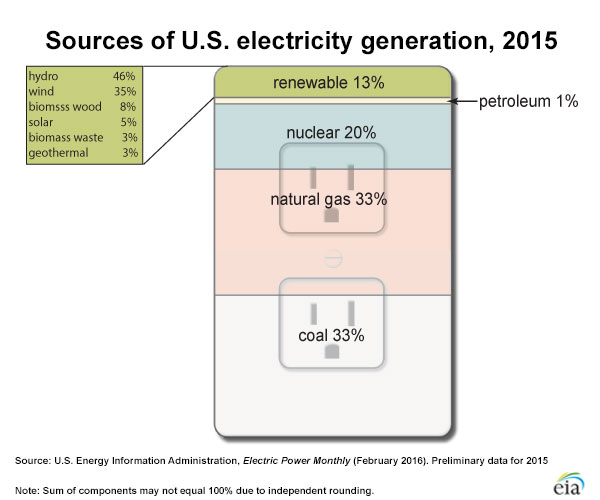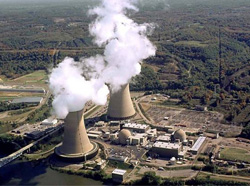8.3: The Water-Energy Nexus
- Page ID
- 15600
Water is a crucial ingredient to develop and produce energy, a portion of which is then used to generate electricity. Most of the electricity in the United States is produced using steam turbines. A turbine converts the kinetic energy of a moving fluid (liquid or gas) to mechanical energy. In a steam turbine, steam is forced against a series of blades mounted on a shaft. The steam rotates the shaft connected to the generator. The generator, in turn, converts its mechanical energy to electrical energy based on the relationship between magnetism and electricity. In steam turbines powered by fossil fuels (coal, petroleum, and natural gas), the fuel is burned in a furnace to heat water in a boiler to produce steam. Energy sources in the U.S. for power generation are summarized in this graphic.

Credit: U.S. Energy Information Administration, Electric Power Monthly (February 2016). Preliminary data for 2015
Note that nearly equal amounts of natural gas and coal are used to generate power and that fossil fuels represent 67% of the sources used. The picture below shows the cooling water coming out of a nuclear power plant in Pennsylvania.

Electricity is in turn used to pump and treat water from surface or aquifer sources and then to treat the resulting wastewater, thus creating this interdependence known as the water-energy nexus. The US Department of Energy recently completed a study entitled The Water-Energy Nexus: Challenges and Opportunities, a summary of which can be read here.
Exercise 3-1
Read this summary and examine the “Sankey” diagram found in the summary (Figure 6). A link for the Sankey diagram is here. How much water is withdrawn for thermoelectric power generation?
The energy sources contained in oil and gas reservoirs require water to extract and process these hydrocarbons. This is especially true in unconventional reservoirs such as shales or other “tight” (low permeability) reservoirs, where several million gallons may be necessary to hydraulically fracture the shale to allow the hydrocarbons to flow out of the reservoir toward the oil or gas well. While all fuel sources use some volume of water for production, some forms of fuel are clearly more water efficient per million British Thermal Units (MMBTUs) as summarized in the table below
|
Energy Resource |
Gallons of Water Used per MMBTU1 |
|
Deep Shale Natural Gas |
0.84 - 3.702 |
|
Coal (no slurry transport) |
2 - 8 |
|
Nuclear |
8 - 14 |
|
Conventional Oil |
8 – 203 |
|
Synfuel - Coal Gasification |
11 - 26 |
|
Oil Shale |
22 - 56 |
|
Tar Sands |
27-68 |
|
Enhanced Oil Recovery (EOR) |
21-2,500 |
|
Biofuels |
>2,500 |
- Source: “Deep Shale Natural Gas: Abundant, Affordable, and Still Water Efficient”, GWPC, 2010.
- The transport of natural gas can add up to two gallons per MMBTU.
- Includes refining which consumes a major portion (90%) of the water needed (7-18 gal per MMBtu).
Exercise 3-2
What fuel source is most water efficient per MMBTUs of energy produced in the table above?


